In the first in our series looking at chemistry’s holy grails from 25 years ago we examine how matter can now be controlled at its most basic level
The first holy grail paper was written by IBM researcher Phaedon Avouris, excited by the power of new tools that were enabling chemists to manipulate matter at the atomic level.
In 1981, IBM’s Gerd Binnig and Heinrich Rohrer designed the first scanning tunnelling microscope (STM), an invention that soon saw them awarded a physics Nobel prize. Four years later, Binnig patented the atomic force microscope (AFM), a similar device that probes materials’ atomic structures by measuring the force between sample and tip, rather than electric current as is the case with the STM. Today, many instruments incorporate the two systems into the same device, allowing force and current to be analysed simultaneously.
We got excited that besides being able to see ‘the atoms’, we could also make changes in that scale
Phaedon Avouris, IBM Research
Prior to these discoveries, Avouris was using diffraction methods to study the chemistry and physics of solid surfaces, but he quickly realised the power of the new techniques. ‘When the STM came along, I got involved early on and started seeing what we usually refer to as “the atoms” – basically some representation of the charge density of the atomic arrangements. We were just totally flabbergasted. It was so revealing,’ he recalls. ‘It was so different to what diffraction had told us at sort of a macroscopic average structure, there were so many local variations, defects, different domains of structures [revealed by STM].’
Avouris and his team would work late into the night to minimise the effect that vibrations made by people walking around the building would have on their ultra-precise experiments. ‘As we went along, we noticed that there were changes on the surface as we were scanning it over and over,’ he remembers. ‘And after we did some careful experimentation, we realised that some of the changes were not spontaneous – we were actually inducing these movements of atoms.’
It became apparent that as the STM tip moved, mechanical forces could slide atoms along the surface. By applying a current, atoms could even be made to hop from the surface to the tip and back again. ‘We got excited that besides being able to see “the atoms”, we could also make changes in that scale, which was really unheard of up to that point. It was tremendous excitement,’ says Avouris.
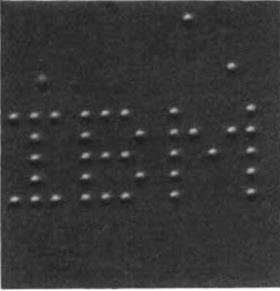
A string of stunning experiments followed, showcasing the incredible level of control that chemists could now exert over their samples. In an iconic demonstration in 1990, IBM’s Don Eigler and Erhard Schweizer used STM at very low temperatures to manoeuvre 35 xenon atoms across a crystalline nickel surface, spelling out the company’s name. Three years later, Eigler’s lab used similar techniques to build a ring of 48 iron atoms on a copper surface. This was dubbed the ‘quantum corral’ due to the extraordinary standing wave patterns produced by surface electrons trapped inside the structure.
‘After that initial burst of results and optimism, for many years, it was a slowly dawning realisation that it was simply harder than we imagined to take the next steps,’ says Chris Lutz, who joined Eigler’s team in 1990. ‘There was plenty of new physics obtained by arranging well-separated atoms on close-packed surfaces, but it was hard to see the atomic arrangements in any close-packed structure, to identify the element of a given atom, or to put the atoms where we wanted to make a molecule.’
Identifying atoms
A major breakthrough came in 2000, when a group led by Saw-Wai Hla, then at the Free University of Berlin, used STM to perform an Ullmann coupling reaction. First they used a voltage pulse from the STM tip to abstract iodine from two iodobenzene molecules. Then they used the tip to drag the two resulting phenyls next to each other, before supplying enough activation energy to fuse them together and form a biphenyl molecule.
Soon after, a group led by Oscar Custance and Seizo Morita at Osaka University, Japan, performed some astonishing room temperature manipulations with an AFM. In 2005, they used an AFM to carry out controlled lateral manipulations of atoms within the top layer of a semiconductor. Three years later they showed atoms in a semiconductor’s upper layer could be interchanged with atoms coming from the AFM tip. The team even showed that it was possible to distinguish different types of atoms with the AFM.
‘I think that was definitely a big milestone in atom manipulation,’ says Leo Gross, the team leader of IBM’s atom and molecule manipulation group in Zurich, Switzerland. Gross explains that Custance’s findings inspired his team to start using AFM, previously having focused solely on STM.
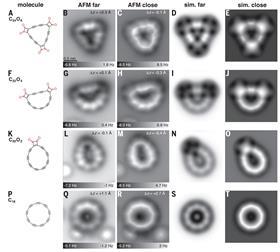
In 2009, Gross’ team made another leap forwards. By attaching a single carbon monoxide molecule to the AFM tip, they could drastically improve the resolution of their images to the point that they could view individual bonds within organic molecules. The CO tip even enables Gross and his co-workers to distinguish different types of bonds. Last year, they used the technique to study a rare carbon allotrope, whose structure had been debated by theoretical chemists for years. Rival groups had argued that cyclo[n]carbons could either take on a ‘polyynic’ structure, formed from alternating single and triple carbon–carbon bonds, or a ‘cumulenic’ structure with consecutive double bonds. The problem was that these compounds are highly reactive and very difficult to study.
Gross’ team started with a masked version of the molecule that had been prepared by Harry Anderson’s group in Oxford. The masking groups stabilised the material enough for it to be deposited onto an inert surface, cooled down to 5K. ‘Then with voltage pulses we could remove these masking groups and form the ring,’ says Gross. ‘Then we used our high resolution imaging and what we saw was a nine-fold symmetric structure, where the nine triple bonds become bright, giving more repulsion in the AFM, and the single ones become dark. So from taking these images we could actually find out that it’s a polyynic structure.’
Data storage’s future?
Other technical advances are opening up the possibilities for atomic manipulation. One of the driving forces for this research has been the desire to create nanoscale devices, and ever smaller data storage.
Thirty years ago, it took Eigler and Schweizer 22 hours of continuous work to spell out ‘IBM’ with 35 atoms. By 2016, it took the same amount of time for an automated STM to write a kilobyte of data, controlling the positions of more than 8100 chlorine atoms on a copper surface. Sander Otte’s team at the Technical University of Delft used this system to perform Monte Carlo simulations and to code passages from Richard Feynman’s There’s Plenty of Room at the Bottom lecture and Darwin’s On the Origin of Species.
Today, Lutz is in charge of IBM’s nanomagnetism project and is aiming to push the limits of data storage even further by controlling individual atoms’ spins. ‘Starting around the year 2000 we began looking more intensely into magnetic properties, and we built a new machine that could cool to half a Kelvin, and had a magnetic field up to a few Tesla, which let us look at the Zeeman energy to flip the spin of an atom,’ says Lutz. In 2012, they made a magnetic memory bit out of just 12 iron atoms. With a single current pulse from the STM tip, the IBM team could flip the spin of all 12 atoms simultaneously – switching the tiny antiferromagnets between two magnetic states.
And in recent years, the group has developed a way to use electron spin resonance with the STM. This gives them the ability to control the nuclear spins of individual atoms, and even use those atoms as sensors to measure the magnetic properties of other atoms nearby.
‘It amazes me nearly every day that we are looking at atoms one at a time. Often, I pause and think about how there is one atom that we’re studying today, sitting inside the helium dewar that I’m standing next to, and it’s likely to be there in just the same spot tomorrow,’ says Lutz. ‘What that atom does can change my day for the worse or for the better, and its performance represents what every atom of that isotope would do in the same circumstances.’
A few years after writing the holy grail paper, Avouris’ research changed direction and he went on to make major contributions to the field of carbon nanotechnology, before retiring in 2016. But he looks back fondly on his time as an atom manipulator. ‘It is a really beautiful field, it gives you a unique insight into the world of atoms and molecules in real space. I still love it,’ he says. ‘My happiest years of my research life were when, late at night, me and my postdoc would sit there in front of the screen and admire the exotic landscapes that we saw in front of our eyes.’
Correction: This article was updated on 29 September, a previous version gave an incorrect affiliation for Oscar Custance’s early work on room temperature manipulations and did not mention Seizo Morita was the co-leader.
Citation race caption: This plot shows the 20 most cited papers related to atomic and molecular manipulation that have been published in the last 25 years. Many of these papers are related to the fabrication of nanoelectronics and also to the analysis of biomolecules. With 896 citations, Leo Gross’ paper on using an AFM with CO tips to identify individual bonds within organic molecules is the fourth highest ranked paper – despite being one of the most recently published papers in the top 20
Citation network caption: This chart links researchers who have been cited in key papers on atomic manipulation over the last quarter of a century to the authors of those papers. There appear to be distinct groups who are commonly cited by each other. The largest node on the far right of the image is Gerd Binnig, the co-inventor of both the scanning tunnelling microscope and atomic force microscope, who was awarded the 1986 Nobel prize in physics for his work on the STM. The large cluster in the middle shows many of the researchers whose work is discussed in this story, including Don Eigler, Oscar Custance and Saw-Wai Hla. Phaedon Avouris appears in the large left-of-centre cluster alongside other researchers with interests in nanotechnology, while the furthest left group highlights researchers known for their work on biomolecules
Co-authorship network caption: In this chart, researchers are connected to other researchers with whom they have published key papers on atomic and molecular manipulation. Oscar Custance appears as a dark blue node in one of the clusters to the right of centre – this colouring signifies that his first key paper in our data set was published between 1995–1999. Leo Gross, whose key paper on CO tips for AFMs was published in 2009, appears as a lighter blue node slightly below Custance. The large number of small clusters illustrates the wide ranging applications of tools such as STM and AFM, as well as other molecular manipulation techniques like optical tweezers. The large node in the centre of the chart is the University of Bristol’s Jonathan Reid whose group use optical and electrodynamic techniques to analyse aerosol particles
Geo caption: This map shows the location of authors of important papers on atomic manipulation published since 1995. It appears that most of the major players in this field are concentrated in the US, Europe and Japan. We can see the growth in the field in the late 1990s to early 2000s, following some lean years in the mid-1990s
Additional information
For an explanation of how these data visualisations were built, read Behind the data
Further reading
1 M Garg and K Kern, Attosecond coherent manipulation of electrons in tunneling microscopy, Science, 2020, 367, 411 (DOI: 10.1126/science.aaz1098)
2 X Zeng et al, Nanoscale tailoring of supramolecular crystals via an oriented external electric field, Nanoscale, 2020,12, 15072 (DOI: 10.1039/d0nr01946a)
3 A Sweetman, N R Champness and A Saywell, On-surface chemical reactions characterised by ultra-high resolution scanning probe microscopy, Chem. Soc. Rev., 2020,49, 4189 (DOI: 10.1039/d0cs00166j)
4 R J P Román et al, Tunneling-current-induced local excitonic luminescence in p-doped WSe2 monolayers, Nanoscale, 2020,12, 13460 (DOI: 10.1039/d0nr03400b)
5 D Peller et al, Sub-cycle atomic-scale forces coherently control a single-molecule switch, Nature, 2020, 585, 58 (DOI: 10.1038/s41586-020-2620-2)
6 M R Tchalala et al, Tip-induced oxidation of silicene nano-ribbons, Nanoscale Adv., 2020, 2, 2309 (DOI: 10.1039/d0na00332h)
7 S Ghamari et al, Dielectrophoretic borophene tweezer: Sub-10 mV nano-particle trapping, Appl. Surf. Sci., 2020, 527, 146859 (DOI: 10.1016/j.apsusc.2020.146859)
8 V Jansson et al, Growth mechanism for nanotips in high electric fields, Nanotechnology, 2020, 31, 355301 (DOI: 10.1088/1361-6528/ab9327)
9 M Leisegang et al, Guiding a proton—controlled directionality in a single molecule, J. Phys. Chem. C, 2020, 124, 10727 (DOI: 10.1021/acs.jpcc.0c01913)
10 J Qi et al, Force-activated isomerization of a single molecule, J. Am. Chem. Soc., 2020, 142, 10673 (DOI: 10.1021/jacs.0c00192)

Searching for the holy grails of chemistry
- 1
- 2
 Currently reading
Currently readingExquisite control of individual atoms is deepening our understanding of chemistry
- 3
- 4
- 5
- 6
- 7
- 8
- 9


















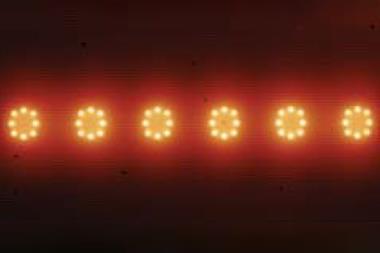
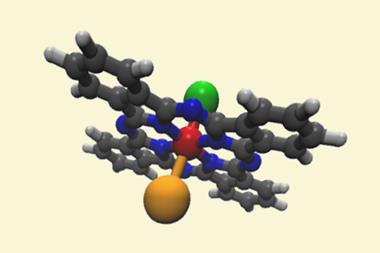
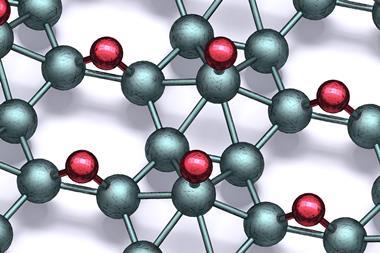
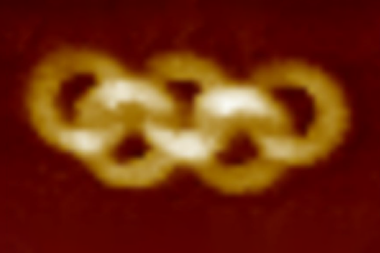

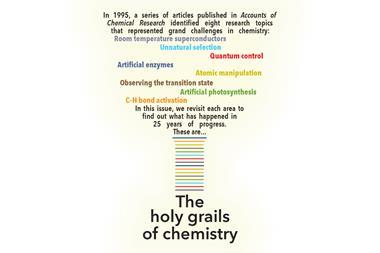
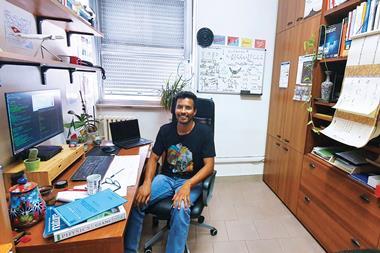




No comments yet